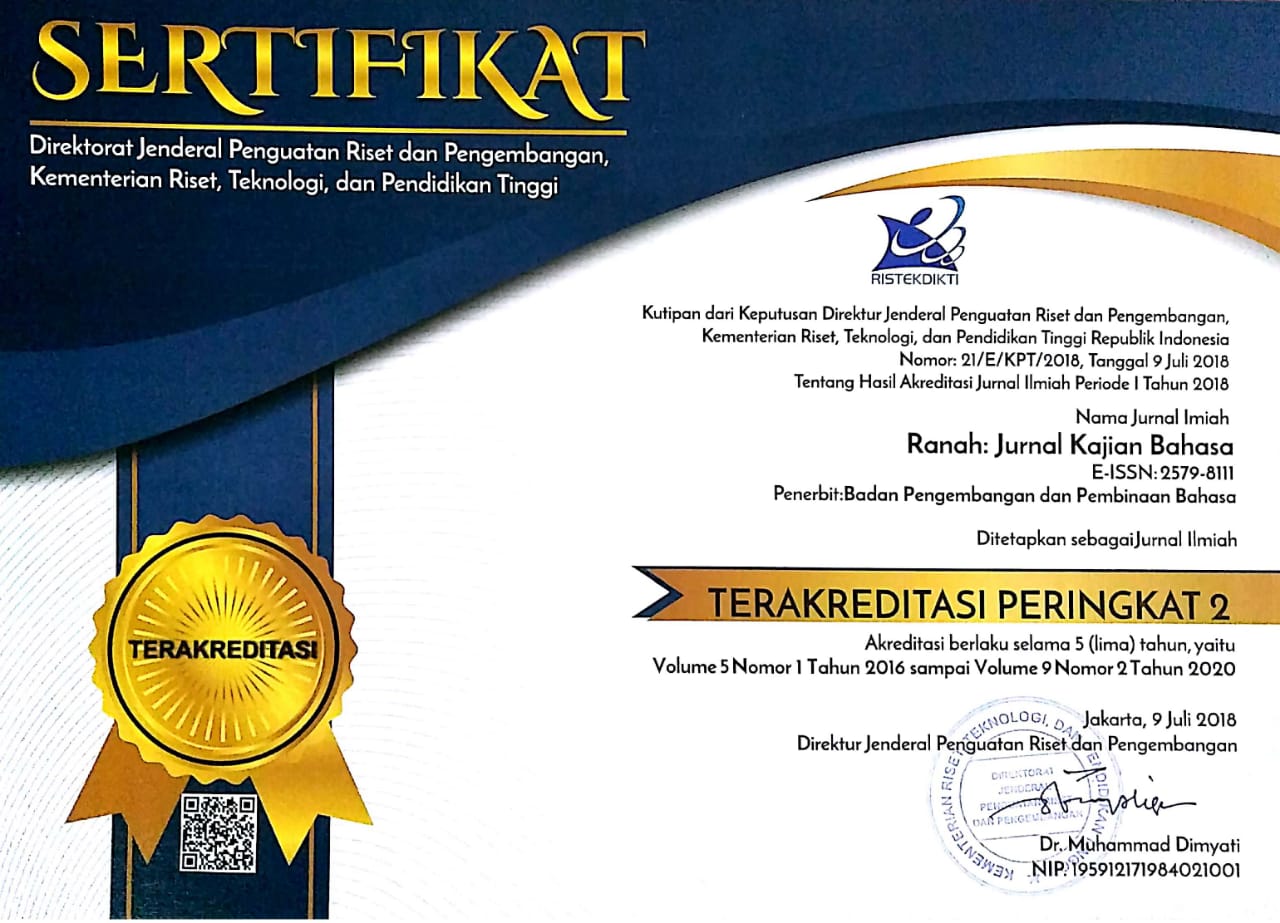Pemerolehan Kosakata Bahasa Korea Pada Pembelajar Dewasa Indonesia
Abstract
This study aims to find out the effects of Korean songs and videos on vocabulary size of adult Korean language learners through one-way communication. To collect the data, three respondents participated in a picture-naming task in Korean and questionnaire is used to know the frequency of the participants in listening to Korean songs and watching Korean videos. The result showed that acquiring vocabularies on adult learners is difficult because of motivation and age factors. All participants of this study have exposed to Korean content media for more than five years, yet none of them got a perfect score on vocabulary test, but they got different motivations for learning Korean. It can be concluded, the higher the motivation on learner is the better result the learner’s got. Korean vocabulary acquisition by listening to Korean songs and watching Korean videos is possible yet not easily acquired by adult learners.
ABSTRAK
Penelitian ini bertujuan untuk mengetahui pengaruh lagu dan video Korea pada kosakata pembelajar Bahasa Korea dewasa melalui komunikasi satu arah. Untuk mengumpulkan data, tiga responden berpartisipasi dalam penamaan gambar dalam Bahasa Korea dan kuesioner digunakan untuk mengetahui frekuensi peserta dalam mendengarkan lagu Korea dan menonton video Korea. Hasil penelitian menunjukkan bahwa memperoleh kosakata pada pelajar dewasa sulit karena motivasi dan faktor usia. Semua peserta penelitian ini telah terpapar ke media berkonten Korea selama lebih dari lima tahun, namun tidak satupun dari mereka mendapat nilai sempurna pada tes kosakata, tetapi mereka mendapat motivasi yang berbeda untuk belajar Bahasa Korea. Dapat disimpulkan bahwa semakin tinggi motivasi pada pelajar adalah hasil yang lebih baik pelajar dapatkan. Pemerolehan kosakata Bahasa Korea dengan mendengarkan lagu-lagu Korea dan menonton video Korea adalah mungkin namun tidak mudah diperoleh oleh pembelajar dewasa.
Keywords
Full Text:
PDFReferences
Bintari, F. (2017). Frequency of Watching English Movies with Indonesian Subtitles and Students' Vocabulary Mastery. Unpublished undergraduate thesis. Universitas Negeri Malang, Malang.
Deng, F., & Zou, Q. (2016). A Study on Whether the Adults' SecondLanguage Acquisition Is Easy or Not-From the Perspective of Children's Native Language Acquisition. Theory and Practice in Language Studies, 6(4), 776-780. DOI: https://doi.org/10.17507/tpls.0604.15
Dulay, H., Burt, M., & Krashen, S. (1982). Language Two. New York: Oxford University Press.
Febriana, M. (2017). Building Early Childhood Learner's Vocabulary by Using BBC Learning English Video. In Rozimela, Y., Jufrizal, Fatimah, S., Amri, Z., Anwar, D., Refnaldi, et al. (Eds.), Challenges and Opportunities in Multi-Dimensional English Language Teaching in Changing EFL Contexts. Proceedings of the Fifth International Seminar on English Language and Teaching (ISELT-5) (pp. 97-100). Padang, Indonesia.
Teng, M. F. (2016). Development of Morphological Awareness through English Songs: A Case Study. Chinese Journal of Applied Linguistics, 39(2). DOI: https://doi.org/10.1515/cjal-2016-0011
Hanifah, M. (2014). Frequency of Watching English Movies with Indonesian Subtitles and Students' Vocabulary Mastery. Unpublished undergraduate thesis. Universitas Negeri Malang, Malang.
Hu, R. (2016). The Age Factor in Second Language Learning. Theory and Practice in Language Studies, 6(11), 2164-2168. DOI: https://doi.org/10.17507/tpls.0611.13
Nadiyah. (2014). Uncovering Factors Related to Incidental Vocabulary Acquisition: an Experimental Study on Indonesian EFL Learners. Unpublished undergraduate thesis. Universitas Negeri Malang, Malang.
Nugroho, S. (2010). Hallyu di Indonesia: Selama Dekade Pertama di Abad Ke-21. In Syamsuddin, M., Setiawan, N. A., Indrastuti, N. S. K., Nugroho, S. A., Seonhee, M., & Dianawati, L. (Eds.), Sejarah Korea Menuju Masyarakat Modern: Beberapa Peristiwa Penting (pp. 49-67). Yogayakarta, Indonesia.
Purwiyanti, Y., Suwandi, S., Andayani. (2017). Strategi Komunikasi Pemelajar Bahasa Indonesia bagi Penutur Asing (BIPA) Asal Filipina. Ranah: Jurnal Kajian Bahasa, 6(2), 160-179. DOI:
https://doi.org/10.26499/rnh.v6i2.448
Saville-Troike, M. (2006). Introducing Second Language Acqusition. Cambridge: Cambridge University Press. DOI: https://doi.org/10.1017/CBO9780511808838
Schumann, J. (2013). Societal Responses to Adult Difficulties in L2 Acquisition: Toward an Evolutionary Perspective on Language Acquisition. Language Learning: A Journal of Research in Language Studies, 63(1). DOI: https://doi.org/10.1111/j.1467-9922.2012.00744.x
Susilowatik, A. (2016). Kesulitan Mahasiswa Program Studi D3 Bahasa Korea Sekolah Vokasi Universitas Gadjah Mada dalam Belajar Bahasa Korea. Unpublished final project. Universitas Gadjah Mada, Yogyakarta.
Verstegen, S. (2014). Receptive Vocabulary Development of Children Acquiring Chinese, Swedish and Korean as Measured by the PPVT-4. Unpublished undergraduate thesis. Utrecht University, Netherlands. Retrieved from https://dspace.library.uu.nl-/bitstream/handle/1874/297052/Scriptie%20Saskia%20Verstegen.pdf?sequence=2
DOI: https://doi.org/10.26499/rnh.v8i2.962
Refbacks
- There are currently no refbacks.








